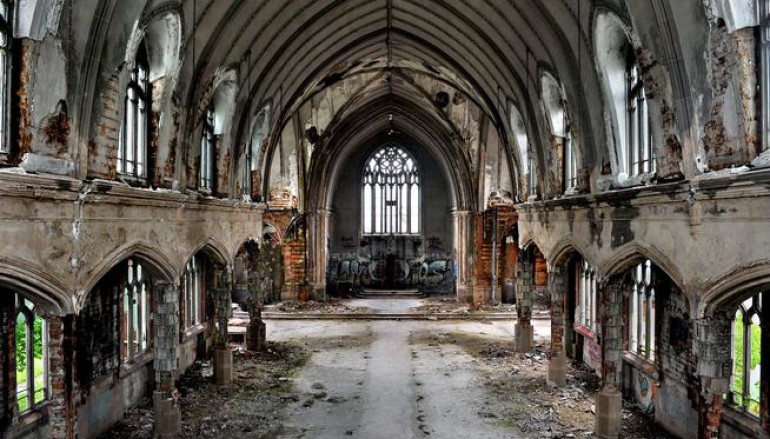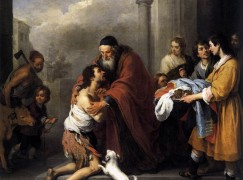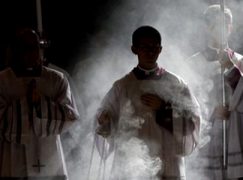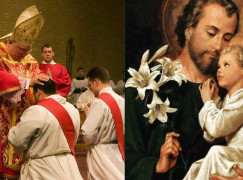

The Catholic “Man-Crisis”
By Matthew Christoff:
There is a serious “man-crisis” in the Catholic Church. It is widespread and serious. Unless the Church, including its bishops, priests and lay men begin to take notice and make the evangelization of Catholic men a priority, the Catholic Church in the west will decay, as more and more men abandon the Church. There can be no New Evangelization unless there is a New Emangelization, creating generations of Catholic men who are on fire for Jesus Christ and His Catholic Church. Here are some of the statistics that are part of a growing New Emangelization data base that documents the extent of the Catholic “man-crisis”:
Unchecked, the exodus of Catholic men from the faith is likely to continue as men become increasingly casual about Catholicism.
- About 11 million adult men in the U.S. were raised Catholic but left the faith[1] and men are under-represented in the Church versus their share of the total population (46% of parishioners are male versus 49% of the population).[2]
Casual Catholic men lack passion for the faith.
- Men don’t believe that Catholicism is unique and essential for a happy life.
- 8 out of 10 men agree that “how one lives is more important than being a Catholic.”[3]
- 4 in 10 men believing that Catholicism does not have a “greater share of truths than other religions.”[4]
- Only 38% of Catholic men strongly agree that they are “proud to be Catholic.”[5]
- Only 26% of Catholic men consider themselves to be “practicing Catholics.” [6]
- Only 34% of Catholic men strongly agree that Catholicism is “among the most important part of life.” [7]
- Men don’t believe that the Sacraments and Devotions of Catholicism are important.
- A large majority of Catholic men (57%) are not certain it is possible to have a personal relationship with God.[8]
- Only 51% of Catholic men strongly agree that the “Sacraments are essential to their relationship with God.”[9]
- Only 32% of Catholic men strongly agree that the “Sacraments are essential to their faith.”[10]
- Many men are not moved by the Mass and are less moved than women across the various aspects of the Mass: the readings and the Gospel, homily, music, the Eucharist, prayer, worshiping with other people, the presence of God. [11]
- 48% of men agree that “Mass is boring”[12] and 55% agree that they “don’t get anything out of the Mass.”[13]
- Only 29% of men believe that weekly mass attendance is “very important.”[14]
- Only 28% of Catholic men believe that Confession is “very important”.[15]
- Only 31% of men strongly agree that it is “very important” to attend Mass on Holy Days. [16]
- Only 39% of men strongly agree that the Sacrament of Anointing of the Sick is “very important.” [17]
- Only 43% of Catholic men believe that it is “very important to help those in need.” [18]
- Only 30% of Catholic men believe it is “very important to have a Devotion to Mary” and only 23% believe it is “very important to have a devotion to the Saints.” [19]
- Only 37% of Catholic men strongly agree that “daily prayer is important”[20] and only 33% of Catholic men pray on a daily basis.[21]
- 49% of Catholic men feel that they “cannot explain their faith to others.”[22]
- During the last 20 years, men have become less certain about being Catholic: in 1987, 50.1% men said they would “never leave the Church”[23]; in 2005 the number had fallen to 42.3%.[24] This means that almost 60% of Catholic men would consider leaving the Church; these men have become “Casual Catholics”, Catholics who are casual about the faith.
Catholic men’s ambivalence about Catholicism results in low involvement.
- Only about 1/3 of Catholic men (33%) say they attend Mass on a weekly basis.[25]
- One third of Catholic men (34%) are not formally members of a parish.[26]
- A large portion (42%) of Catholic men attend Mass “a few times per year” or “seldom or never.”[27]
- 75% of Catholics go to Confession “less than once a year” (30%) or “never” (45%).[28] While data is not available for men’s participation, is likely worse given that men are significantly less likely to believe that Confession is very important.[29]
- Almost half of Catholic men do not engage in a routine of prayer; praying only “occasionally or sometimes” or “seldom or never.”[30]
- 83% of Catholic men rarely or never participate in a parish activity outside of the Mass.[31]
For comparison, Catholic men are less passionate about faith than other Christian men.
- Less than half of Catholic men (48%) feel that “religion is very important in their lives; this compares to 74% for Evangelical men.”[32]
- Only about 4 in 10 Catholic men (43%) have an absolutely certain belief in a personal God; this compares to 69% of evangelical men.[33]
- Less than half of Catholic men (48%) pray outside of worship services, which compares to 71% of Evangelical men.[34] Clearly, there is a “passion problem” among Catholic men.
The prevalence of so many Casual Catholic Men matters, for it will further weaken the Church in future years.
- Catholic parents are doing a poor job at passing along the faith to their children,[35] especially fathers.[36]
- Indeed, less than 50% of men (47.5%) strongly agree that it is important for their children to be Catholic.[37]
- This is troubling since younger people are becoming increasingly vulnerable to leaving the Catholic Church, particularly young men. In 1987, 41.6% of 18-29 year olds agreed with the statement “I would never leave the Church”;[38] by 2005, only 17.8% of those 18-30 years said they’d “never leave the Church.”[39] This means that an astounding 82.2% of young people would consider leaving the Church.
- 42% of emerging adults have “very or somewhat different” religious beliefs as their Catholic fathers.[40]
- Males are particularly vulnerable to leaving the Church; 15% of the U.S. population have left religion and are now “unaffiliated”; the largest portion of this growing group are males who were formerly Catholic.[41]
The loss of Catholic men and the growing numbers of Casual Catholic men have other negative effects on parishes and the Church.
- Fewer men reduce the pool for priestly and religious male vocations.
- Lower levels of active adult men also influences young men to become disengaged from the Church. The “face” of the Church is feminine; men are underrepresented in the pews (only 37% of regular mass attendees are men).[42]
- Further, a Notre Dame study shows that 70-90% of catechesis, service, bible study activities are led by women, causing the authors to suggest that “young males…assume that serious religious studies are a women’s business,” resulting in greater numbers of younger men being disengaged.[43]
- Men are needed for healthy and growing parishes; research shows that congregations with greater portions of men are more likely to be growing.[44]
- Men are much more influential in the conversion of their families than women. Research shows that when a woman converts to Christianity, 17% of the time the whole family converts. When a man converts, 93% of the time the whole family converts.[45]
[1] Luis Lugo et al., “Faith in Flux,” The Pew Forum on Religion and Public Life (April 2009): 1. Estimate based on: a) Pew notes that 9% of U.S. Adults have left Catholicism, b) U.S. Census data that shows there are 250 million U.S. adults and that men represent 49% of adults.
[2] Luis Lugo et al., “U.S. Religious Landscape Survey,” The Pew Forum on Religion and Public Life (June 2008): 63.
[3] “Gallup Poll of Catholics, 2005”, Question 18, http://www.thearda.com/Archive/Files/Codebooks/GALLUP05_CB.asp.
[4] Ibid., Question 19.
[5] Mark M. Gray and Paul M. Perl, “Sacraments Today: Belief and Practice among U.S. Catholics”, Center for Applied Research in the Apostolate – “CARA” (April 2008): 100.
[6] Ibid., 100.
[7] Ibid., 103.
[8] Lugo, “U.S. Religious Landscape Survey”, 29.
[9] Gallup, 2005, Question 21.
[10] CARA, 2008: 100.
[11] CARA, 2008: 41.
[12] “Gallup Survey of Chicago Catholics, 2007”, Question 126, http://www.thearda.com/Archive/Files/Codebooks/CHICATH_CB.asp.
[13] Gallup, 2007, Question 130.
[14] Gallup 2007, Question 61.
[15] Gallup 2007, Question 62.
[16] CARA 2008, 47.
[17] CARA 2008, 66.
[18] CARA 2008, 108.
[19] CARA 2008, 108.
[20] Gallup 2007, Question 63.
[21] Gallup 2007, Question 137.
[22] Gallup 2005, Question 23.
[23] “Gallup Poll of Catholics (1987),” Question 48, http://www.thearda.com/Archive/Files/Descriptions/GALLUP87.asp.
[24] Gallup 2005, Question 75.
[25] Gallup 2005, Question 59.
[26] Gallup 2005, Question 5.
[27] Gallup 2005, Question 94.
[28] CARA 2008, 57.
[29] CARA 2008, 38.
[30] Gallup 2005, Question 60.
[31] Gallup 2007, Question 157.
[32] “U.S. Religious Landscape Survey (2008),” 24.
[33] “U.S. Religious Landscape Survey (2008),” 29.
[34] “U.S. Religious Landscape Survey (2008),” 46.
[35] Christopher Smith and Patricia Snell, Souls in Transition (New York: Oxford University Press, 2009), 114.
[36] “Souls in Transition,” 129.
[37] Gallup 2005, Question 22.
[38] Gallup 1987, Question 48.
[39] Gallup 2005, Question 75.
[40] Smith and Snell, 128-129.
[41] Barry A. Kosmin, et al., “American Nones: The Profile of the No Religion Population,” American Religious Identification Survey (2008): 5,7.
[42] Gallup 2005, Question 75.
[43] David C. Leege and Thomas A. Trozzolo, “Participation in Catholic Parish Life: Religious Rites and Parish Activities in the 1980s,” Notre Dame Study of Catholic Parish Life, Issue 3 (1985): 14.
[44] C. Kirk Hadaway, “Facts on Growth,” Hartford Institute for Religion Research (2006): 4.
[45] Attributed to evangelist, Sid Woodruff: www.e-n.org/2790-A-man%27s-influence.htm.








